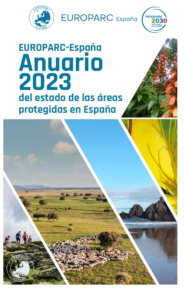State of play of Protected Areas in Spain
The commitment to Protected Areas in Spain is strong, with more than 36% of the land surface area protected and, shortly, 21% of the marine surface area.
Yearbook 2023 on the state of Protected Areas in Spain
The Yearbook of Protected Areas in Spain 2023, – published by EUROPARC Spain on the 18th of March 2024 and available in Spanish language – showcases the state of the art of Protected Areas in this country and includes an analysis of several aspects of concern.
Spain has 36.7% of the protected land area and 12.3% of the marine area, a figure that will soon rise to 21%. It stands out as the country with higher contribution of Protected Areas to the European Natura 2000 network, and the one with the highest number of biosphere reserves in the world, with 53 designated territories. These figures provide a solid basis for tackling many of the commitments related to the European Union’s Biodiversity Strategy.
Partnerships for conservation and socio-economic revitalisation
Protected Areas are essential tools within environmental, social and economic policies. Furthermore, in an increasingly urbanised society, they provide access to nature and to its enjoyment – Spanish National Parks alone receive almost 14 million visitors.
Protected Areas are also areas of opportunity for green activity and employment, especially in rural areas.
says Juana Barber, President of EUROPARC Spain.
Additionally, initiatives such as the European Charter for Sustainable Tourism in Protected Areas (ECST) – promoted by the EUROPARC Federation – are an example scheme that allows quality recognition for products and services from Protected Areas. The ECST has involved 30 protected natural areas in Spain, 526 tourism companies and 10 travel agencies that voluntarily participate in the initiative.
Active management, experiences and field practices
Protected Areas play an essential role not solely in the conservation and restoration of ecosystems and their biodiversity. There is growing evidence and experiences of the role that Protected Areas play in tackling the challenges of climate change, articulating the necessary cooperation between sectoral policies and stressing the socio-economic benefits of nature conservation.

Among other experiences, the Yearbook of Protected Areas in Spain 2023 portrays examples on the contribution of Protected Areas to the different future challenges we, as a society, face. Such is the case of an European project for adaptation to climate change in a Natural Park in Galicia and an initiative for climate change mitigation in the Natural Parks of the Chartered Community of Valencia. Likewise, we can find examples like the commitment to conservation and revitalisation of rural areas in a recently created Natural Park in La Rioja and the experience of a decade of collaborative work to promote sustainable tourism in La Gomera island, driven by Garajonay National Park.
The report is available online at EUROPARC Spain website in Spanish language – take a closer look to this significant report by clicking the button below.
To the Yearbook 2023 page